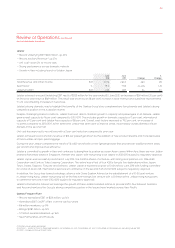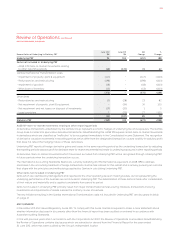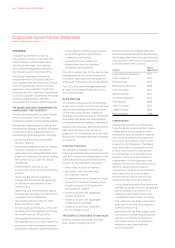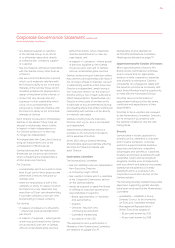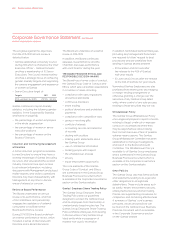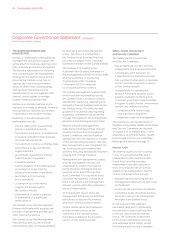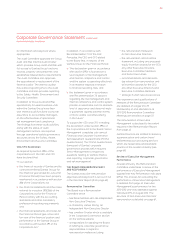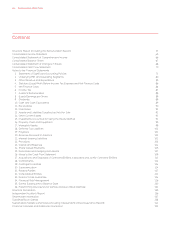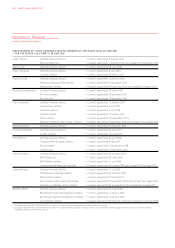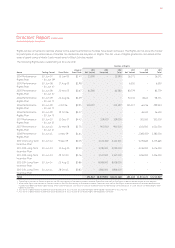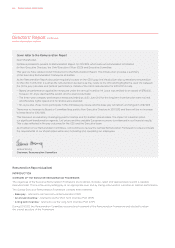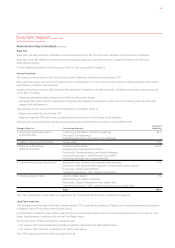Qantas 2012 Annual Report Download - page 35
Download and view the complete annual report
Please find page 35 of the 2012 Qantas annual report below. You can navigate through the pages in the report by either clicking on the pages listed below, or by using the keyword search tool below to find specific information within the annual report.
FOR THE YEAR ENDED 30 JUNE 2012
Corporate Governance Statement continued
for information and approval where
appropriate.
The Audit Committee approves the Group
Audit and Risk Internal Audit Charter
which provides Group Audit and Risk with
full access to Qantas Group functions,
records, property and personnel, and
establishes independence requirements.
The Audit Committee also approves
the appointment or replacement of the
internal auditor. The internal auditor
has a direct reporting line to the Audit
Committee and also provides reporting
to the Safety, Health, Environment and
Security Committee.
In addition to Group Audit and Risk,
operationally focussed business units
within the Qantas Group have their
own internal audit functions to provide
assurance to accountable managers
on the effectiveness of operational
risk management and compliance.
The findings from these audit activities,
along with the status of audit
management actions, are reported
through operational safety governance
structures and to the Safety, Health,
Environment and Security Committee.
CEO/CFO Declaration
As required by section 295A of the
Corporations Act, the CEO and CFO
have declared that:
“In our opinion:
a the financial records of Qantas and its
controlled entities (Qantas Group) for
the financial year ended 30 June 2012
(Financial Period) have been properly
maintained in accordance with section
286 of the Corporations Act;
b the financial statements and the notes
referred to in section 295(3)(b) of the
Corporations Act for the Financial
Period comply with the accounting
standards and other mandatory
professional reporting requirements;
and
c the financial statements and notes for
the Financial Period give a true and
fair view of the financial position and
performance of the Qantas Group in
accordance with section 297 of the
Corporations Act.”
In addition, in accordance with
Recommendation 7.3 of the ASX
Principles, the CEO and CFO stated
to the Board that, in respect of the
Qantas Group for the Financial Period:
a “the declaration given in accordance
with section 295A is founded on a
sound system of risk management
and internal compliance and control
and the system is operating effectively
in all material respects in relation
to financial reporting risks; and
b the statement given in accordance
with Recommendation 7.3 (above)
regarding the risk management and
internal compliance and control system
provide a reasonable, but not absolute
level of assurance and does not imply
a guarantee against adverse events
or more volatile outcomes arising
in the future.”
To support the CEO and CFO in making
the declaration under section 295A of
the Corporations Act to the Board, Senior
Management completes a bi-annual
Financial and Corporate Governance
Self Assessment Questionnaire (FCGSA
Questionnaire). The FCGSA Questionnaire
forms part of Qantas’ corporate
governance process which requires
Senior Management to respond to
questions relating to Qantas’ finance
and reporting, corporate governance
and risk management.
THE BOARD REMUNERATES FAIRLY
AND RESPONSIBLY
The Qantas executive remuneration
objectives and approach is set out in full
in the Directors’ Report (from page 42).
Remuneration Committee
The Board has a Remuneration
Committee which:
— has three members who are Independent
Non-Executive Directors
— is chaired by James Strong, an
Independent Non-Executive Director
— has a written Charter which is available
in the Corporate Governance section
on the Qantas website
— is responsible for assisting the Board
in fulfilling its corporate governance
responsibilities in regard to
remuneration matters including:
— the remuneration framework
for Non-Executive Directors
— the remuneration and incentive
framework, including any proposed
equity incentive awards for the CEO,
any other Executive Directors,
Executive Committee Members
and Senior Executives
— recommendations and decisions
(as relevant) on remuneration and
all incentive awards for the CEO,
any other Executive Directors and
Executive Committee Members
— strategic human resources policies
The experience and qualifications of
Members of the Remuneration Committee
are detailed on pages 12 to 15.
Membership of and attendance at
2011/2012 Remuneration Committee
Meetings are detailed on page 37.
The remuneration of Executive
Management is disclosed to the extent
required in the Remuneration Report
from page 42.
Qantas Directors are entitled to statutory
superannuation and certain travel
entitlements (accrued during service)
which are reasonable and standard
practice in the aviation industry (see
page 61).
Review of Executive Management
Performance
At least annually, the Remuneration
Committee undertakes a review of the
performance of Executive Management
against their Key Performance Indicators
(KPIs). The process for evaluating the
performance of Executive Management
is detailed from page 42. Executive
Management’s performance for the
2011/2012 year was assessed against
individual KPIs in August 2012. The
structure of Non-Executive Directors’
remuneration is detailed on page 61.
033


